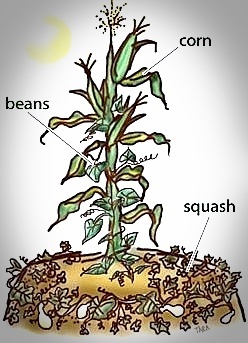We need to learn more of the old ways, and adapt them to today’s situations. Where I live, the oldest ways are of Aboriginal, Indigenous, Native origin. In Master chef and educator Dan Barber’s agitating book, The Third Plate: Field Notes on the Future of Food, he pays respect to the Iroquois’ Three Sisters Strategy, a farming strategy that shouted out to me… “Here is a guide, Ben, to managing conflict in the workplace and organization.” Thank you associative mind.
The Three Sisters Strategy
 “Iroquois planted most of their corn – alongside dry beans and squash, a companion planting strategy called the Three Sisters.
“Iroquois planted most of their corn – alongside dry beans and squash, a companion planting strategy called the Three Sisters.
On the continuum of farming practices, Three Sisters is at the opposite end from how corn is typically grown, with its military-row mono-cultures and chemical-fed soil.
The logic is to carefully bundle crops into relationships that benefit each other, the soil, and the farmer.
The beans provide the corn with nitrogen (legumes; e.g., beans, draw nitrogen from the air into the soil); the corn stalk provides a natural trellis for the climbing beans (so Jack wouldn’t need to stake the beans); and the squash, planted around the base of the corn and beans, suppresses weeds and offers an additional vegetable to harvest in the late fall.”
Let’s learn from our ancesters. Let’s apply Three Sisters wisdom into today’s urban workplace. Let’s see it as a metaphor for relationships, collaboration, and conflict management. Here’s how I see it, in the workplace and in the organization:
Organization Leaders
The farmer is a leader. And, like the farmer, the organization leader, manager, or supervisor, perspires, inspires, and encourages the members of the organization to better ways of dealing with conflict; a role model of conflict competence. Yet, the leader is not too proud to say, at the end of the day, “thank you”, for by the grace of…
Organization Membership
As with the interplay between corn, dry beans, and squash, the organization succeeds when its diverse members succeed, as individuals, and collectively; through personal growth and constructive interactions and relationships, the connections between. Each person is to be nourished and supported in their quest for conflict competence and conflict mastery.
Environment
The soil is the environment in which the crops grow and prosper. Lousy environment, lousy crops. Similarly, a healthy workplace culture and environment are pre-conditions for effective communications, and ultimately, conflict competent people and organization. Create a safe environment, spaces; ones that encourages authentic, constructive conversations. We transform through conversations.
Good things come in threes. The Three Sisters strategy; for conflict management in the workplace, and in the organization. Learning from the elders.
Dan Barber’s insights and work is stellar. I’ve written about him, before. Once a farm boy always a farm boy.

Speak Your Mind